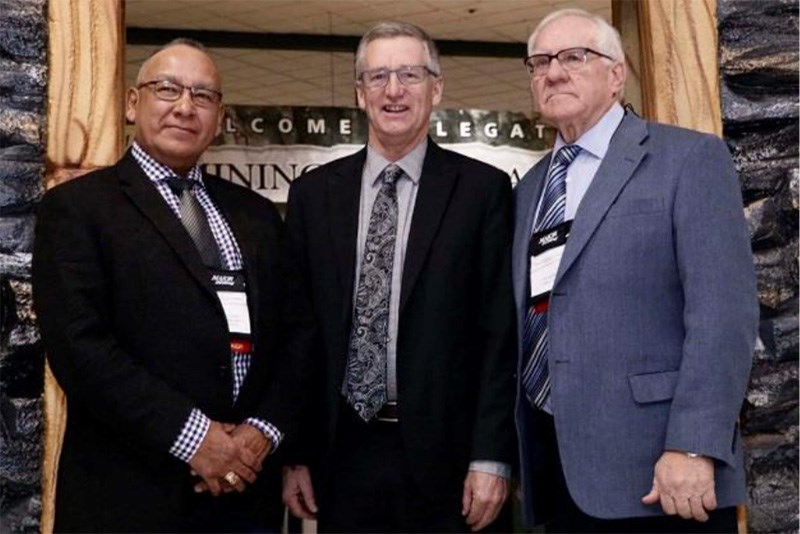An association representing mineral prospectors and developers says that comments made by a government minister about the Manitoba-First Nations Mineral Development Protocol report could endanger the province’s mining industry, particularly in the north.
“The comments of Manitoba’s honourable minister of growth, enterprise and trade during the public announcement of the Manitoba First Nations Mineral Development Protocol implied that the First Nation communities’ consent would be required before exploration permits would be issued,” said an Aug. 29 statement from Manitoba Saskatchewan Prospectors and Developers Association (MSPDA) president Stephen Masson. “He went on to say that communities could decide not to have exploration and mining in their traditional land use areas , which is essentially a veto which would have huge implications for the survival of Manitoba’s mining industry.”
The report, by former Manitoba cabinet minister Jim Downey and former Norway House Cree Nation chief and Assembly of Manitoba Chiefs grand chief Ron Evans, is intended to help the provincial government develop processes to effectively foster cooperation between the mining industry and First Nations with mineral resources in their traditional territories. The report includes a proposed Crown–Aboriginal consultation process guide, a matrix for mineral development, and clear time frames for various actions to take place, and also identifies opportunities to strengthen partnerships and to help First Nations benefit from mining projects in their vicinity.
When Downey and Evans delivered their report to the government in June, Growth, Enterprise and Trade Minister Blaine Pedersen told the Thompson Citizen that developing a protocol would not be about forcing mining projects on First Nations.
“If it turns out a community does not want to do this, this isn’t about us forcing it on them, it’s about a partnership moving forward,” Pedersen said.
Masson said the MSPDA is in favour of the protocol’s development and First Nations participation in mineral development projects in their traditional lands. However, giving them what amounts to a veto on potential new mines going ahead will cause exploration funding to dry up, he fears.
“The Toronto Stock Exchange and the Canadian Stock Exchange are telling their investors not to invest in Manitoba in exploration because of the uncertainty,” said Masson, who lives in Flin Flon and runs a mineral exploration firm. “We don’t see having a veto as something the market will allow us to progress with.”
Without junior miners funding exploration in hopes of finding a rich deposit, Masson fears that mining in Northern Manitoba could be a dead industry within a decade, saying that Hudbay is mining out the Lalor Mine in Snow Lake faster than anticipated and that 777 Mine in Flin Flon has only three or four years left. Thompson, he says, accounts for only a tiny portion of Vale’s worldwide business and the big players aren’t into grassroots exploration anyways.
“Most of the majors have their ground sewn up,” Masson says. “They have all the exploration they need. We need a lot of little guys looking for deposits.”
Mineral exploration firms are already fighting for funding with companies investing in marijuana and those who are only interested in companies seeking out elements that can be used in battery production. The possibility of a further roadblock to mining in Manitoba is not going to make the province a more attractive place to invest, he says.
“Generally overall it’s difficult and in Manitoba we’ve had such bad press with the lack of permitting going ahead” that companies are shifting their exploration activities to Saskatchewan, Ontario and Quebec and have ceased being active in Manitoba at all. “They’ve just packed up and left. It’s not a friendly place anymore.”
The MSPDA has tried to get Pedersen to clarify his remarks but so far they haven’t heard back, Masson said.
Part of the problem may be that many Progressive Conservative MLAs are unfamiliar with mining and the north, as Masson says they are more likely to have farming backgrounds and that most of their attention is directed at Winnipeg.
“It’s hard for them to focus outside of that,” he said. “Every one of really has to squeak for the wheel to get any grease here.”
Without mining as a major economic driver, northern communities could be in trouble, as Masson says each mining job supports two to three other jobs in mining towns.
“The whole north seems to be shutting down,” he said. “It’s going to be very hard for communities to sustain themselves if this trend continues. Money follows certainty. Without certainty investors just won’t go there.”
The MSPDA isn’t the only organization with questions about the Manitoba-First Nations Mineral Development Protocol. The Manitoba Metis Federation said in June that, “The protocol’s process of Metis exclusion as rights-holders will have implications across the province for the mining industry including increased future mining projects risk, delays, and abandonment. This will not create a clear pathway to facilitate mining development or Indigenous reconciliation but just the opposite.”




